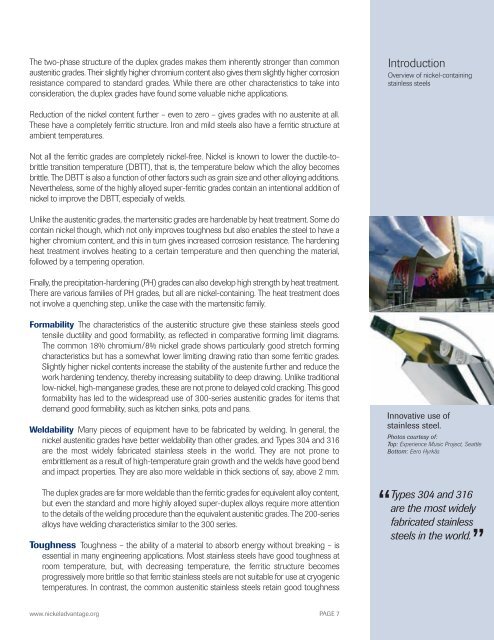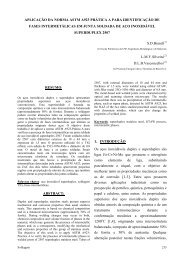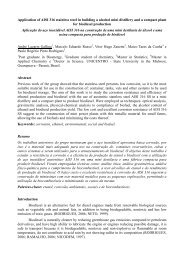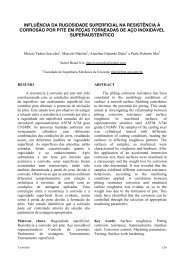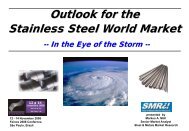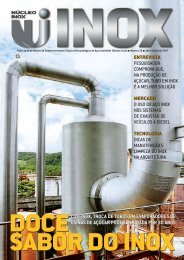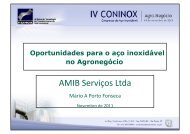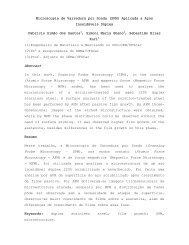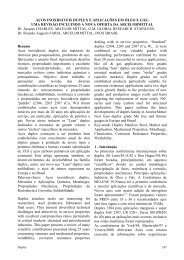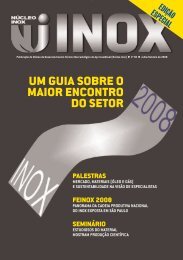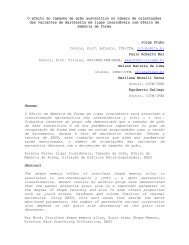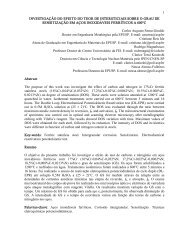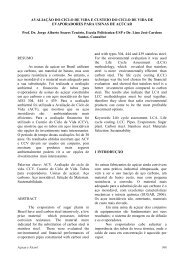The Nickel Advantage - Nickel in Stainless Steel - Eurometaux
The Nickel Advantage - Nickel in Stainless Steel - Eurometaux
The Nickel Advantage - Nickel in Stainless Steel - Eurometaux
Create successful ePaper yourself
Turn your PDF publications into a flip-book with our unique Google optimized e-Paper software.
<strong>The</strong> two-phase structure of the duplex grades makes them <strong>in</strong>herently stronger than common<br />
austenitic grades. <strong>The</strong>ir slightly higher chromium content also gives them slightly higher corrosion<br />
resistance compared to standard grades. While there are other characteristics to take <strong>in</strong>to<br />
consideration, the duplex grades have found some valuable niche applications.<br />
Introduction<br />
Overview of nickel-conta<strong>in</strong><strong>in</strong>g<br />
sta<strong>in</strong>less steels<br />
Reduction of the nickel content further – even to zero – gives grades with no austenite at all.<br />
<strong>The</strong>se have a completely ferritic structure. Iron and mild steels also have a ferritic structure at<br />
ambient temperatures.<br />
Not all the ferritic grades are completely nickel-free. <strong>Nickel</strong> is known to lower the ductile-tobrittle<br />
transition temperature (DBTT), that is, the temperature below which the alloy becomes<br />
brittle. <strong>The</strong> DBTT is also a function of other factors such as gra<strong>in</strong> size and other alloy<strong>in</strong>g additions.<br />
Nevertheless, some of the highly alloyed super-ferritic grades conta<strong>in</strong> an <strong>in</strong>tentional addition of<br />
nickel to improve the DBTT, especially of welds.<br />
Unlike the austenitic grades, the martensitic grades are hardenable by heat treatment. Some do<br />
conta<strong>in</strong> nickel though, which not only improves toughness but also enables the steel to have a<br />
higher chromium content, and this <strong>in</strong> turn gives <strong>in</strong>creased corrosion resistance. <strong>The</strong> harden<strong>in</strong>g<br />
heat treatment <strong>in</strong>volves heat<strong>in</strong>g to a certa<strong>in</strong> temperature and then quench<strong>in</strong>g the material,<br />
followed by a temper<strong>in</strong>g operation.<br />
F<strong>in</strong>ally, the precipitation-harden<strong>in</strong>g (PH) grades can also develop high strength by heat treatment.<br />
<strong>The</strong>re are various families of PH grades, but all are nickel-conta<strong>in</strong><strong>in</strong>g. <strong>The</strong> heat treatment does<br />
not <strong>in</strong>volve a quench<strong>in</strong>g step, unlike the case with the martensitic family.<br />
Formability <strong>The</strong> characteristics of the austenitic structure give these sta<strong>in</strong>less steels good<br />
tensile ductility and good formability, as reflected <strong>in</strong> comparative form<strong>in</strong>g limit diagrams.<br />
<strong>The</strong> common 18% chromium/8% nickel grade shows particularly good stretch form<strong>in</strong>g<br />
characteristics but has a somewhat lower limit<strong>in</strong>g draw<strong>in</strong>g ratio than some ferritic grades.<br />
Slightly higher nickel contents <strong>in</strong>crease the stability of the austenite further and reduce the<br />
work harden<strong>in</strong>g tendency, thereby <strong>in</strong>creas<strong>in</strong>g suitability to deep draw<strong>in</strong>g. Unlike traditional<br />
low-nickel, high-manganese grades, these are not prone to delayed cold crack<strong>in</strong>g. This good<br />
formability has led to the widespread use of 300-series austenitic grades for items that<br />
demand good formability, such as kitchen s<strong>in</strong>ks, pots and pans.<br />
Weldability Many pieces of equipment have to be fabricated by weld<strong>in</strong>g. In general, the<br />
nickel austenitic grades have better weldability than other grades, and Types 304 and 316<br />
are the most widely fabricated sta<strong>in</strong>less steels <strong>in</strong> the world. <strong>The</strong>y are not prone to<br />
embrittlement as a result of high-temperature gra<strong>in</strong> growth and the welds have good bend<br />
and impact properties. <strong>The</strong>y are also more weldable <strong>in</strong> thick sections of, say, above 2 mm.<br />
<strong>The</strong> duplex grades are far more weldable than the ferritic grades for equivalent alloy content,<br />
but even the standard and more highly alloyed super-duplex alloys require more attention<br />
to the details of the weld<strong>in</strong>g procedure than the equivalent austenitic grades. <strong>The</strong> 200-series<br />
alloys have weld<strong>in</strong>g characteristics similar to the 300 series.<br />
Toughness Toughness – the ability of a material to absorb energy without break<strong>in</strong>g – is<br />
essential <strong>in</strong> many eng<strong>in</strong>eer<strong>in</strong>g applications. Most sta<strong>in</strong>less steels have good toughness at<br />
room temperature, but, with decreas<strong>in</strong>g temperature, the ferritic structure becomes<br />
progressively more brittle so that ferritic sta<strong>in</strong>less steels are not suitable for use at cryogenic<br />
temperatures. In contrast, the common austenitic sta<strong>in</strong>less steels reta<strong>in</strong> good toughness<br />
Innovative use of<br />
sta<strong>in</strong>less steel.<br />
Photos courtesy of:<br />
Top: Experience Music Project, Seattle<br />
Bottom: Eero Hyrkäs<br />
Types 304 and 316<br />
are the most widely<br />
fabricated sta<strong>in</strong>less<br />
steels <strong>in</strong> the world.<br />
“<br />
”<br />
www.nickeladvantage.org PAGE 7


